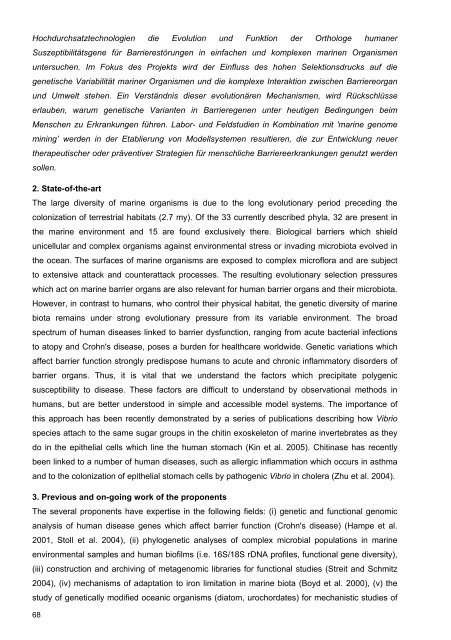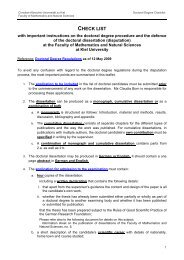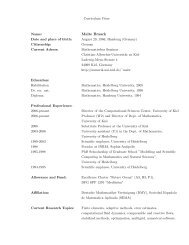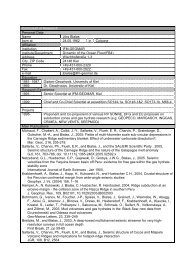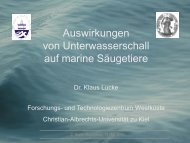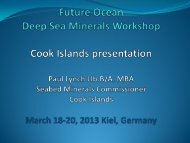Untitled - The Future Ocean
Untitled - The Future Ocean
Untitled - The Future Ocean
- No tags were found...
You also want an ePaper? Increase the reach of your titles
YUMPU automatically turns print PDFs into web optimized ePapers that Google loves.
Hochdurchsatztechnologien die Evolution und Funktion der Orthologe humanerSuszeptibilitätsgene für Barrierestörungen in einfachen und komplexen marinen Organismenuntersuchen. Im Fokus des Projekts wird der Einfluss des hohen Selektionsdrucks auf diegenetische Variabilität mariner Organismen und die komplexe Interaktion zwischen Barriereorganund Umwelt stehen. Ein Verständnis dieser evolutionären Mechanismen, wird Rückschlüsseerlauben, warum genetische Varianten in Barrieregenen unter heutigen Bedingungen beimMenschen zu Erkrankungen führen. Labor- und Feldstudien in Kombination mit 'marine genomemining’ werden in der Etablierung von Modellsystemen resultieren, die zur Entwicklung neuertherapeutischer oder präventiver Strategien für menschliche Barriereerkrankungen genutzt werdensollen.2. State-of-the-art<strong>The</strong> large diversity of marine organisms is due to the long evolutionary period preceding thecolonization of terrestrial habitats (2.7 my). Of the 33 currently described phyla, 32 are present inthe marine environment and 15 are found exclusively there. Biological barriers which shieldunicellular and complex organisms against environmental stress or invading microbiota evolved inthe ocean. <strong>The</strong> surfaces of marine organisms are exposed to complex microflora and are subjectto extensive attack and counterattack processes. <strong>The</strong> resulting evolutionary selection pressureswhich act on marine barrier organs are also relevant for human barrier organs and their microbiota.However, in contrast to humans, who control their physical habitat, the genetic diversity of marinebiota remains under strong evolutionary pressure from its variable environment. <strong>The</strong> broadspectrum of human diseases linked to barrier dysfunction, ranging from acute bacterial infectionsto atopy and Crohn's disease, poses a burden for healthcare worldwide. Genetic variations whichaffect barrier function strongly predispose humans to acute and chronic inflammatory disorders ofbarrier organs. Thus, it is vital that we understand the factors which precipitate polygenicsusceptibility to disease. <strong>The</strong>se factors are difficult to understand by observational methods inhumans, but are better understood in simple and accessible model systems. <strong>The</strong> importance ofthis approach has been recently demonstrated by a series of publications describing how Vibriospecies attach to the same sugar groups in the chitin exoskeleton of marine invertebrates as theydo in the epithelial cells which line the human stomach (Kin et al. 2005). Chitinase has recentlybeen linked to a number of human diseases, such as allergic inflammation which occurs in asthmaand to the colonization of epithelial stomach cells by pathogenic Vibrio in cholera (Zhu et al. 2004).3. Previous and on-going work of the proponents<strong>The</strong> several proponents have expertise in the following fields: (i) genetic and functional genomicanalysis of human disease genes which affect barrier function (Crohn's disease) (Hampe et al.2001, Stoll et al. 2004), (ii) phylogenetic analyses of complex microbial populations in marineenvironmental samples and human biofilms (i.e. 16S/18S rDNA profiles, functional gene diversity),(iii) construction and archiving of metagenomic libraries for functional studies (Streit and Schmitz2004), (iv) mechanisms of adaptation to iron limitation in marine biota (Boyd et al. 2000), (v) thestudy of genetically modified oceanic organisms (diatom, urochordates) for mechanistic studies of68


